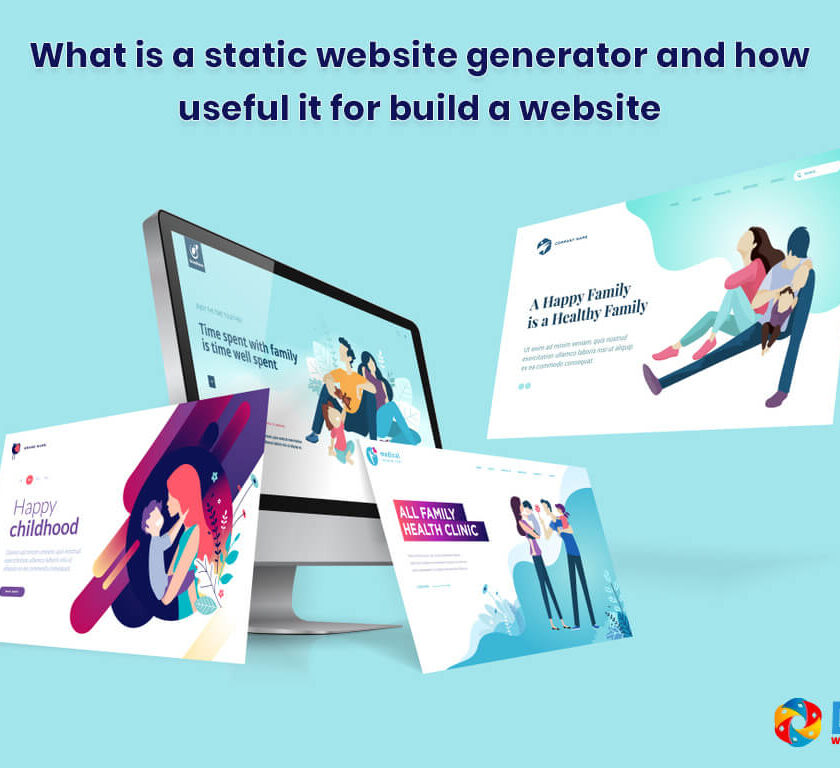First – What Is a Static Site?
Static Website Generator – Static and dynamic websites are the two types of websites that exist. A static website is exactly what it sounds like: it’s permanent, fixed, and unchanging. In other words, it is presented to the user’s web browser in its current state. No matter how many times a user or developer hits the “save” button, nothing has changed. Static pages are created by developers using HTML, CSS, and then uploaded to a server where they remain unchanged until requested by a browser.
CMS-powered dynamic websites development, on the other hand, are constantly evolving. With the CMS, each page is built on-demand as soon as a user clicks on it. Back-end database content is created by developers.
When a user enters a URL, the CMS-driven website retrieves the relevant content from the database, loads an HTML template, renders the content within the template, and returns a formatted HTML page to the visitor’s browser – a process known as server-side processing.

Static Site Generators
static site generators are tools for creating static websites from a set of input files. They’re publishing tools, similar to Adobe Acrobat, which takes an editable format like a Microsoft Word file and turns it into one that’s easy to consume. PDF. To deploy a static site using SSGs, developers create a collection of HTML pages on an HTTP server.
There is no database and no server-side rendering if you think about it this way. Developers use a static site generator to create a static site, which they then deploy to a server. In response to a user request, the server simply locates and returns a file to the user.
A typical WordPress website development must make numerous database queries in order to render a page for each and every user. This is exacerbated if WordPress plugins are being used, as each plugin will need to access database data as well, adding even more time to the overall processing.
For static sites, the web server only needs to return a file instead of constructing a page to be displayed for each HTTP request sent by each client, which greatly improves speed and performance. As a result, it’s not necessary to keep creating the same thing over and over again.

Heightened Security
CMS-powered sites are plagued by security issues, which static website generator address. No database is present because of this. And since there is no database, attackers cannot perform standard hacking attacks such as SQL database injections or take advantage of security holes on the server-side.
Furthermore, malicious attackers have turned their attention to widely used platforms like WordPress, which are used by hundreds of thousands of people every day. Cybercriminals have access to literally hundreds of tools, which they can easily download and run in order to compromise already-existing WordPress, Drupal, and Joomla sites – simply by working through all known vulnerabilities against each CMS system (and its plugins) in search of security holes.
As a result, site administrators must constantly patch their systems with security updates, playing cat and mouse with hackers to keep their systems safe.
Static website design, on the other hand, are virtually impenetrable from the outside. Because no code is running – when a user requests a page, the server simply sends a file containing that page – there are no vulnerabilities to exploit.
Improved Costs and Reliability
The increased dependability that comes with using a static website generator is yet another benefit. This error message will never appear because there isn’t a database for it to connect to. If you’re using a CMS website development, you may run into issues due to spikes in traffic that cause the database to crash or restrict the number of active connections. SSGs, on the other hand, only require the server to host and return flat HTML files, reducing the likelihood of something going wrong along the way.
SSGs also have the advantage of being less expensive. static website generator are simple and cheap to run. You don’t have to worry about updating the system and its plugins, patching the system, or performing backups when you don’t have a database to worry about.
Version Control
static website generator can use a version control system like Git to store all of their source code. With Git, you can go back in time to any previous version of the site. As a result, old files can be accessed and used again, and any changes or mistakes can be undone or corrected right away. CMS databases, on the other hand, are highly unstable.
Content can be added, changed, or deleted at any time by any user with the appropriate permissions. True, you can (and should) back up databases, but even if this is done on a regular basis, it’s likely that some data will be lost if someone makes a mistake or an attacker gains access.
Version control acts as a highly reliable offsite backup. Because all the files required are stored in the version control system’s repository, reverting to an earlier version of the site is as simple as a few keystrokes.
Conclusion:
static website generator are an excellent choice for websites that don’t require the features of a dynamic website. Websites with more than a dozen pages are rare, and those that do require updates only on a regular basis. As a result, CMSs are often unnecessary, slowing down sites, putting them at risk of security breaches, and raising their operating costs.
Fewer moving parts mean faster and better performance with static website generator. They’re also very safe and dependable, and they’re getting more and more feature-rich and powerful all the time. They also require very little maintenance, and they’re cheaper to operate.
These factors suggest that SSG usage will continue to grow in the future, as well as improvements from providers aimed at making it easier for non-technical users to use. Static site generators are becoming increasingly popular among web developers (SSGs).
For a long time, creating, publishing, and editing website content necessitated knowledge of HTML authoring, making these tasks out of reach for the average user. Because of the emergence of content management systems (CMSs), the need for technical support to make changes to web content has been reduced.
CMSs enable non-technical users to manage their own web content and take charge of the design and display of a site.
The downside of CMSs is that they’ve earned as much notoriety for their flaws as they have for their strengths – they can be slow and inefficient to use, and have scalability and security issues. static website generator have made a comeback as a solution to all of these issues and more.
Static site generators have become increasingly popular in recent years due to their ease of use, security advantages, and ability to serve up content quickly. But what exactly are they, how do they affect the web development process, and when should you use one?



1 thought on “What Is A Static Website Generator And How Useful It For Build A Website”
Comments are closed.